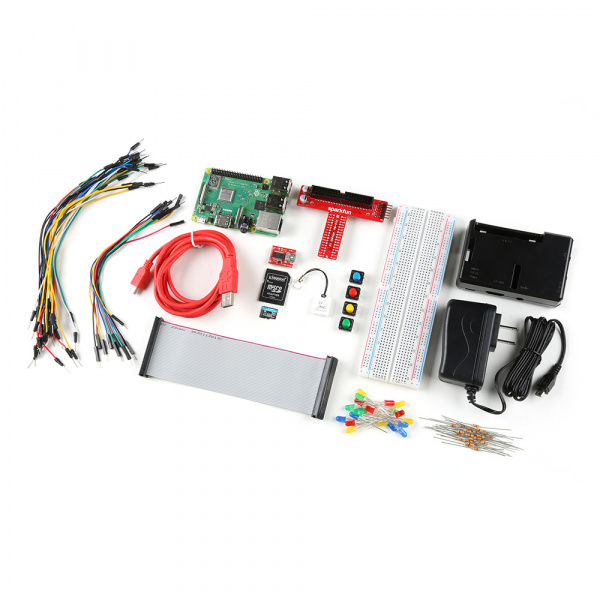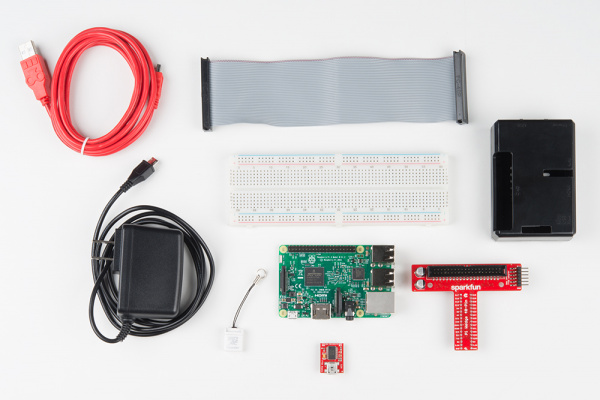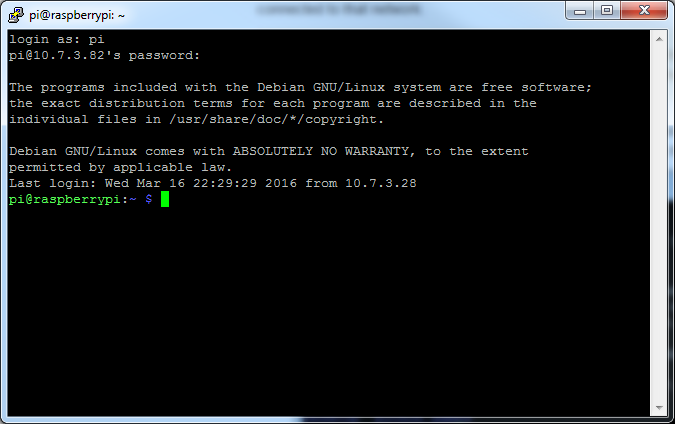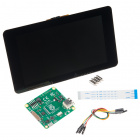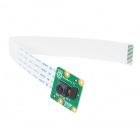Raspberry Pi 3 Starter Kit Hookup Guide
Introduction
Now that the Raspberry Pi 3 Model B and the Pi 3 Model B+ are the latest and greatest in the line of Raspberry Pi Single Board Computers, what's new? This hookup guide goes through the same process of getting going that worked with the Pi 2, but from a Pi 3 point of view.
Raspberry Pi 3 B+ Starter Kit
KIT-23090Covered in This Tutorial
- Kit Assembly
- Getting an OS
- Methods of working with the pi
- Configuring the Pi
- Resources for working with the GPIO
Materials Required
You'll need a mouse, keyboard, and monitor to begin with. Once configured, the pi can be operated from its own peripherals or another computer connected over the internet.
As a desktop, these materials are required:
- Pi 3 Starter kit -or- Pi 3/2 Accessory Kit and your own Pi
- USB Mouse
- USB Keyboard
- HDMI monitor/TV/adapted VGA
After configuration, 'headless' operation over Telnet/SSH requires:
- Pi 3 Starter kit -or- Pi 3/2 Accessory Kit and your own Pi
- 2nd computer connected via internet
- Telnet/ssh terminal software
You'll also need an internet connection to get resources! This link can be wired or wifi and must be available for the Pi. For wireless connections, you can use the on board WiFi antenna.
Suggested Reading and Viewing
You may want to check out the following tutorials and videos before continuing.
- Serial Terminal Basics
- Raspberry gPIo -- Also linked-in later
- Pi Wedge Hookup Guide
- Getting Started With The Raspberry Pi -- video series
Assembly
The Pi is straight-forward and easy to put together, but in the event that something doesn't seem right, this section will give you an idea of what it is supposed to look like.
Snap the Pi into the base of the 'tin', then snap the top into place.
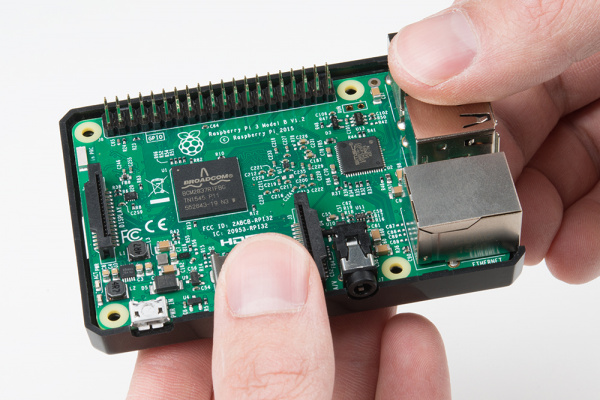
Fit the Pi into the base of the tin. Make sure the Pi is fully seated. Check that the PCB is evenly recessed about the perimeter.
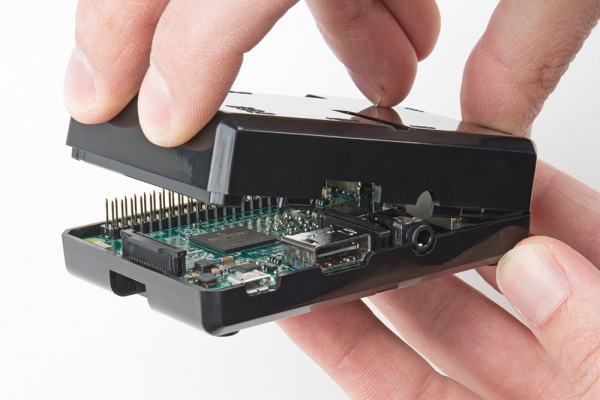
Click the two halves together
Add the SD card

Installing an SD card -- make sure the microSD card is flush with the side of the case when inserted properly. The Pi 3 microSD slot doesn't have a spring as the previous pis did, so if it's flush with the label outward, it is seated correctly.
Connect the ribbon cable to the Pi -- notice that the pin 1 marking is very subtle. Orient the red stripe on the cable towards the SD card. Alternately, pin 1 can be identified by finding the missing/beveled corner of the header's silkscreen on the pi.

The pin 1 location and silkscreen is the same between the Pi B+ and Pi B. This image shows a partially inserted ribbon cable without the case in the way. The ribbon cable is oriented with the red "pin 1" marking pointing towards the SD card slot.
Attach the ribbon cable to the wedge. Pin 1 is pointing towards the FTDI adapter.
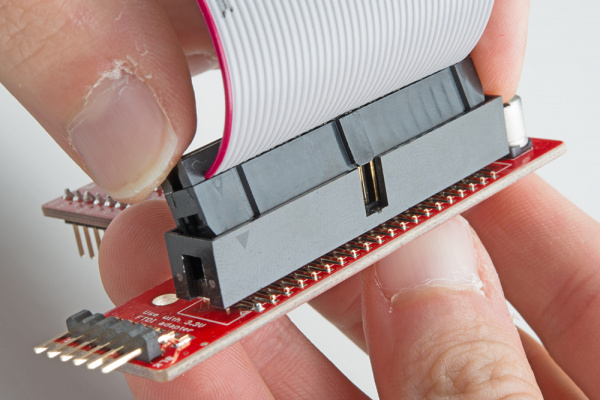
Socket the end of the ribbon cable into the Wedge. It is keyed, but each end of the cable is different. Make sure the ribbon extends away from the breadboard connection.
Socket the Wedge into your breadboard
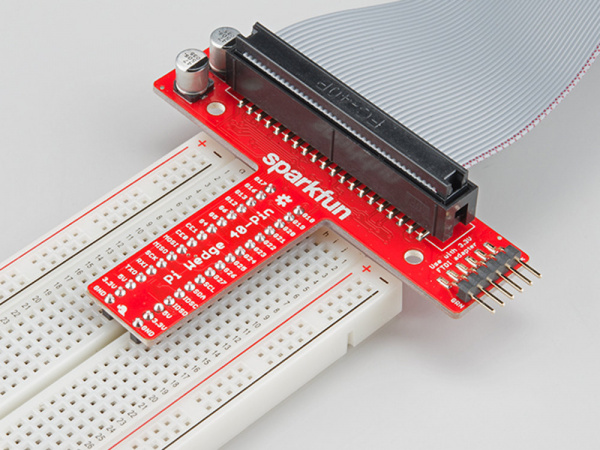
Wedge inserted in breadboard.
Attach the FTDI connector matching "GRN" to "GRN" and "BLK" to "BLK" between the boards.

The FTDI serial adapter is connected matching GRN and BLK connections
Attach desired consumer computer equipment.
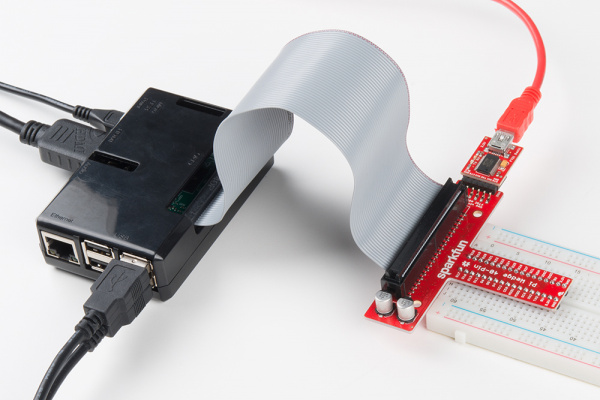
The fully assembled kit. Additional to the kit, user supplied monitor, mouse, and keyboard are shown. This Pi is now a desktop computer.
Getting an OS
Getting a New Image
If something didn't work, or the installation has been corrupted (messing around in the file system were you?), getting a new copy is easy.
- Obtain the Noobs OS from raspberrypi.org.
- Format the card to erase all the files.
- Unzip the contents of the Noobs zip file to the empty, formatted microSD card.
That's it! You're ready to go. For other imaging, check out this tutorial on sd cards and writing images:
SD Cards and Writing Images
You can also check out this guide from the Raspberry Pi foundation.
The First Boot
Before you apply power for the first time, run through this pre-flight checklist.
- Is the microSD card installed and seated firmly?
- Is the HDMI attached and the monitor powered?
- Are the mouse and keyboard plugged in?
- Are the mouse and keyboard standard USB, not wireless? -- Some wireless keyboards have trouble enumerating, so use one you trust.
- Is the whole setup secure on your desk and not liable to jump onto the floor at the first touch?
Ok, you're ready to apply the power to the Pi.
First, you should see a color chart appear on your screen that indicates the Pi has power and is doing something but doesn't have software loaded yet.
Next, Noobs asks if the raspbian distro should be installed. Check the box to select it, and choose your language/keyboard layout here (can also be changed later).
Noobs will take a few minutes to manage the partitions and install the OS.
When it's done, it should report that the OS was installed successfully. Click OK, the Pi will reboot into a graphical interface.
The Noobs default configuration is to auto-log in as user pi, password raspberry.
Performing a Full System Upgrade
Once connected to the Internet (see the Configuring the Pi section), it can be a good idea update all the packages that are currently installed. Usually, new packages replace old ones that are faulty, but sometimes new packages have bugs of their own. If your current system is stable and all the functions are good, maybe don't upgrade. If you're starting a fresh project though, get everything up-to-date before you start putting in the work.
Enter the following commands in the shell (process takes about 10 minutes).
sudo apt-get update-- go fetch the latest package information.sudo apt-get upgrade-- And answer Y. Upgrades all the packages. This stage will take a while.sudo shutdown -r now-- Reboot the machine.
Methods of Working with the Pi
Once the Pi is configured, there are a few methods of using it depending on if you want to use it like a desktop or manage it remotely.
This section covers using the Pi in the following ways
- Using HDMI-out -- Operate your Pi like a desktop computer.
- Using the serial terminal -- some functionality but buggy in the latest Raspbian release.
- Using SSH -- Operate through a network linked to another computer.
Using HDMI-out
Noobs 1.8.0, with Raspbian, automatically logs in and starts a graphical user interface.
If configured to boot to shell, log in with pi as the user name and raspberry as the password. Then, enter startx in the command line to enter a graphical environment where you are presented with a desktop-type menu-driven operating system.
If you need to get back to text land, you can either
- log off through the Task Bar Menu -- drops back to the shell, closing down the X window system
- open xterm from the Task Bar -- opens a shell in a graphical window
- Use CTRL-ALT-1 through CTRL-ALT-8 -- gives you a number of shells, with 7 being the graphic environment (if loaded).
Remember, shutdown with the menu item or enter sudo shutdown -h now from a shell, and wait for the system to halt before removing power.
Using the Serial Terminal without a Monitor
Connect the FTDI (or any USB-to-serial converter) to the mini-usb cable and plug into a usb port on your computer.
Set the terminal settings to 72000 baud, 8 bit, no parity, 1 stop and no flow control. This is an odd rate that is 1.6 times slower than before. Also, CPU frequency effects the symbol rate so be careful if using this interface, and plan for administering by a different method.
Using SSH
A good way to operate a Pi is to attach it to the local network somewhere, then manage it from another computer connected to that same network.
To do this, download PuTTY or a similar SSH terminal for your system and connect to the Internet port used by the pi. The TTY interface gives you a serial-like interface but with colors that make it a little nicer to use.
To obtain your IP address, get to a terminal, and use the command ifconfig. Alternately, hover the mouse pointer over the network icon on the task bar.
With Ethernet and wireless attached, ifconfig returns something like the following:
language:bash
pi@raspberrypi:~$ ifconfig
eth0 Link encap:Ethernet HWaddr b8:a8:3b:56:1a:f7
inet addr:14.7.3.188 Bcast:14.7.3.255 Mask:255.255.255.0
UP BROADCAST RUNNING MULTICAST MTU:1500 Metric:1
RX packets:3026 errors:0 dropped:0 overruns:0 frame:0
TX packets:462 errors:0 dropped:0 overruns:0 carrier:0
collisions:0 txqueuelen:1000
RX bytes:229516 (224.1 KiB) TX bytes:60888 (59.4 KiB)
lo Link encap:Local Loopback
inet addr:127.0.0.1 Mask:255.0.0.0
UP LOOPBACK RUNNING MTU:65536 Metric:1
RX packets:8 errors:0 dropped:0 overruns:0 frame:0
TX packets:8 errors:0 dropped:0 overruns:0 carrier:0
collisions:0 txqueuelen:0
RX bytes:1104 (1.0 KiB) TX bytes:1104 (1.0 KiB)
wlan0 Link encap:Ethernet HWaddr 74:df:21:5b:a3:9c
inet addr:32.8.0.142 Bcast:32.8.0.255 Mask:255.255.255.0
UP BROADCAST RUNNING MULTICAST MTU:1500 Metric:1
RX packets:120 errors:0 dropped:40 overruns:0 frame:0
TX packets:12 errors:0 dropped:4 overruns:0 carrier:0
collisions:0 txqueuelen:1000
RX bytes:20955 (20.4 KiB) TX bytes:9956 (9.7 KiB)
If it looks similar but the IP addresses aren't present, that network link hasn't been established.
In this example, we know our Ethernet is on IP 14.7.3.188 and our wireless on 32.8.0.142. These can be entered into the PuTTY configuration window to begin the session. From here, it just works like the serial link!
Configuring the Pi
This section goes over configuring the keyboard, wired, and wireless internet.
Configuring the Keyboard Layout
The Raspbian distribution comes defaulted to European hardware. With US keyboards, the " (quotation mark) symbol is replaced by @ (commercial at) and our number sign # is replaced by the European pound sign £. This can make it aggravating when trying to #define things. Invoke the config tool with "sudo raspi-config," and take the following actions:
Set the default locale for the system
- Select "Internationalisation Options"
- Select "Change Locale"
- Deselect en_GB.UTF-8 UTF-8
- Select en_US.UTF-8 UTF-8, (Ok)
- Set default to en_US.UTF-8, (Ok)
Change the keyboard layout -- from the Internationalisation Options menu,
- Change Keyboard Layout
- Leave set as: Generic 105-key (Intl) PC (Ok)
- Select Other (Ok)
- Select English (US) (Ok)
- Select English (US) (Ok)
- Select default (Ok)
- Select No compose key (Ok)
- Set Ctrl+Alt+Bksp function (Ok)
Finish with the dialog and get back to the shell
- Try the " and # keys at the prompt. It may be necessary to restart the pi at this point.
Configuring the Internet Interfaces
Automatic Configuration
Raspbian does a good job of configuring wireless networks automatically. By default, DHCP is configured so that the Pi will receive an IP address when a network cable is plugged it to the Ethernet port or when a wireless network is connected.
To use the graphical network tool, right click on the icon on the right side of the task bar, and click "WiFi Networks (dhcpcdui) Settings". Then, select the interface desired (wlan0 or eth0) to disable the DHCP and set your own IP, if necessary.
To connect to a wireless network, click on the icon, select the desired network, and enter the password.
Hovering over the icon will bring up a status of wlan0 and eth0 that also shows the IP address.
Manual (text-based) Configuration
At this time, the network configuration works out of the box so there's really nothing to configure, but in case something goes awry, here's the basics of what can be played with and a known-working configuration to compare with.
A configuration file, interfaces, configures both wired and wireless devices. Enter the following command into a terminal to edit the interfaces file.
language:bash
sudo nano /etc/network/interfaces
Replace "nano" with "leafpad" if you prefer graphics. Here's what our Pi 3 is using:
language:bash
# interfaces(5) file used by ifup(8) and ifdown(8)
# Please note that this file is written to be used with dhcpcd
# For static IP, consult /etc/dhcpcd.conf and 'man dhcpcd.conf'
# Include files from /etc/network/interfaces.d:
source-directory /etc/network/interfaces.d
auto lo
iface lo inet loopback
iface eth0 inet manual
allow-hotplug wlan0
iface wlan0 inet manual
wpa-conf /etc/wpa_supplicant/wpa_supplicant.conf
allow-hotplug wlan1
iface wlan1 inet manual
wpa-conf /etc/wpa_supplicant/wpa_supplicant.conf
By default, this file is set up to get its configuration from /etc/wpa_supplicant/wpa_supplicant.conf, which is really the proper place for wifi information. Here are the contents:
language:bash
ctrl_interface=DIR=/var/run/wpa_supplicant GROUP=netdev
update_config=1
network={
ssid="myNetworkSSID"
psk="mySuperSecurePassword"
key_mgmt=WPA-PSK
}
Applying the Changes
Sometimes the link should be cycled for a new configuration to take. Rather than shutting down the pi and restarting, use 'ifdown' and 'ifup' to bring the link down and back up.
For wireless connections, use
sudo ifdown wlan0
and
sudo ifup wlan0
For wired connections, use
sudo ifdown eth0
and
sudo ifup eth0
Reading Inputs and Toggling the LEDs
This section contains instructions for getting the software necessary to compile programs that use the GPIO, then redirects to our Raspberry gPIo tutorial.
Getting WiringPi for Using C++
The WiringPi library is required to operate the GPIO with C++. There are two methods to get it, mentioned below. Either way, it will have to be built before use.
Get From the WiringPi
git://git.drogon.net/wiringPi" is not available.
Wiring Pi is previously not included with early versions of Raspbian. This required users to download and install it. Luckily, Wiring Pi is included in standard Raspbian systems. If you are looking to update using a mirrored Wiring Pi with small updates to support newer hardware, we recommend checking out this GitHub repository.
You'll need git (may be installed by default). If git is not installed, enter the following into the command line.
language:bash
sudo apt-get install git-core
We highly recommend using Git to download the latest version. To check what version you have, enter the following command.
language:bash
gpio -v
If you receive an output similar to to the following with the Unknown17, you'll want to update WiringPi on a Raspberry Pi 4 or above.
language:bash
gpio version: 2.50
Copyright (c) 2012-2018 Gordon Henderson
This is free software with ABSOLUTELY NO WARRANTY.
For details type: gpio -warranty
Raspberry Pi Details:
Type: Unknown17, Revision: 02, Memory: 0MB, Maker: Sony
* Device tree is enabled.
* --> Raspberry Pi 4 Model B Rev 1.2
* This Raspberry Pi supports user-level GPIO access.
Enter the following to remove the wiringPi and configuration files.
language:bash
sudo apt-get purge wiringpi
Then type the following for the Pi to remove all locations that remember wiringPi.
language:bash
hash -r
As long as you have Git installed, these commands should be all you need to download and install Wiring Pi.
language:bash
git clone https://github.com/WiringPi/WiringPi.git
This will make a folder in your current directory called WiringPi. Head to the Wiring Pi directory.
language:bash
cd WiringPi
Then pull the latest changes from the origin.
language:bash
git pull origin
Then enter the following command. The ./build is a script to build Wiring Pi from the source files. This builds the helper files, modifies some paths in Linux and gets WiringPi ready to rock.
language:bash
./build
At this point, the library should work. Run the gpio command shown below to view some information about the wiringPi version and the Pi that it is running on.
language:bash
gpio -v
Entering the following command will draw a table illustrating the configuration for the pins in the 40-pin connector.
language:bash
gpio readall
Getting Python
Raspbian comes with Python pre-installed. Continue to the gPIo tutorial to find out how to use it.
Using the GPIO.
This excellent tutorial covers all the INs, OUTs, and PWMs of GPIO with the Pi platform.
Raspberry gPIo
Resources and Going Further
Raspberry Pi Accessories
If you are looking to add additional features, check out the accessories to power your Raspberry Pi remotely, build a homemade motion-activated security system, or go retro by building your own arcade controller to emulate classic video games!
SparkFun PiRetrocade
KIT-14007With the Pi 3 reading buttons and toggling LEDs, you're sure to be the coolest kid on the block, but what else can it do? Let us know how you use your Pi 3 in the comments! Otherwise, here are some links to our other Pi resources.
- Raspberry Pi Forums: Is Your Pi Not Booting? - Troubleshooting tips and solutions for a Raspberry Pi that is not booting up.
- The gPIo tutorial
- The SPI and I2C tutorial
Need some inspiration? Check out these tutorials and projects.
Graph Sensor Data with Python and Matplotlib
SparkFun Auto pHAT Hookup Guide
SparkFun Qwiic Quad Solid State Relay Kit Hookup Guide
Qwiic SHIM Kit for Raspberry Pi Hookup Guide
Or check out some of these blog posts for ideas:
